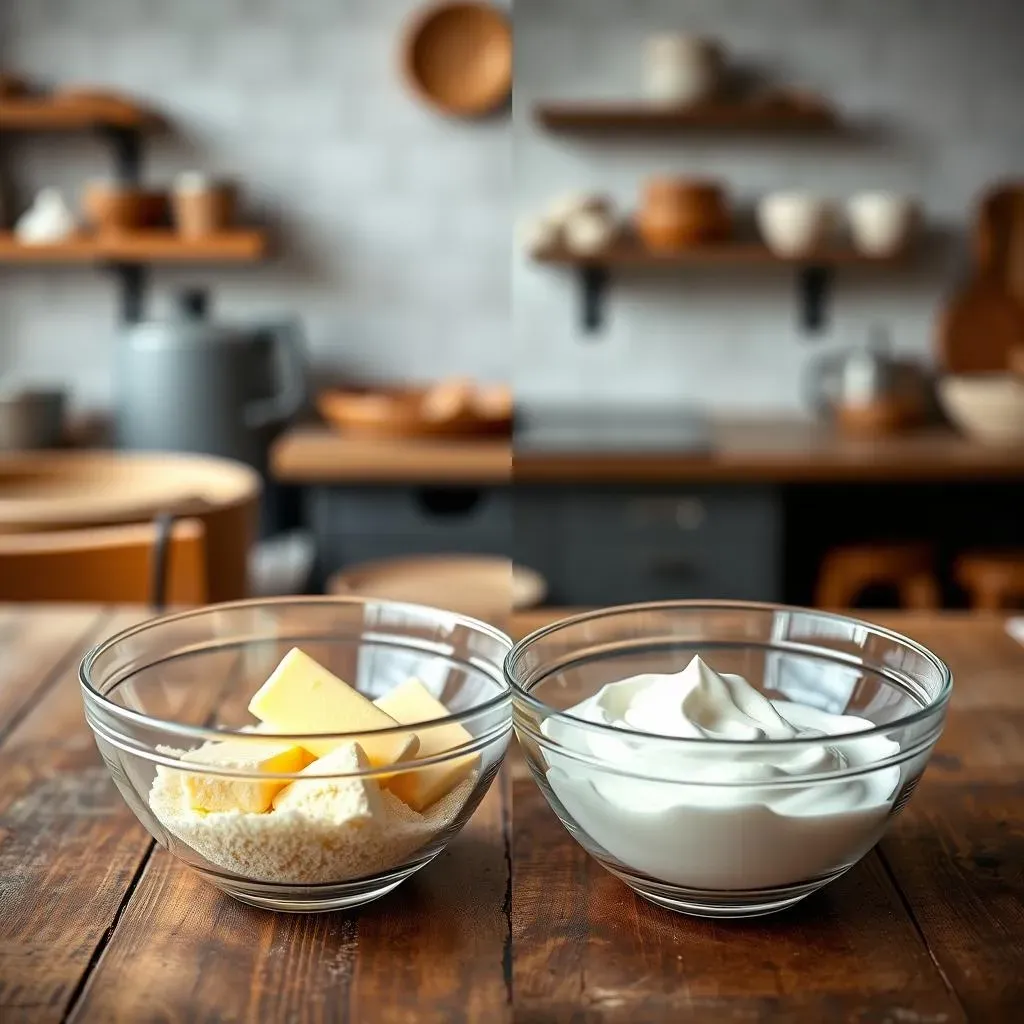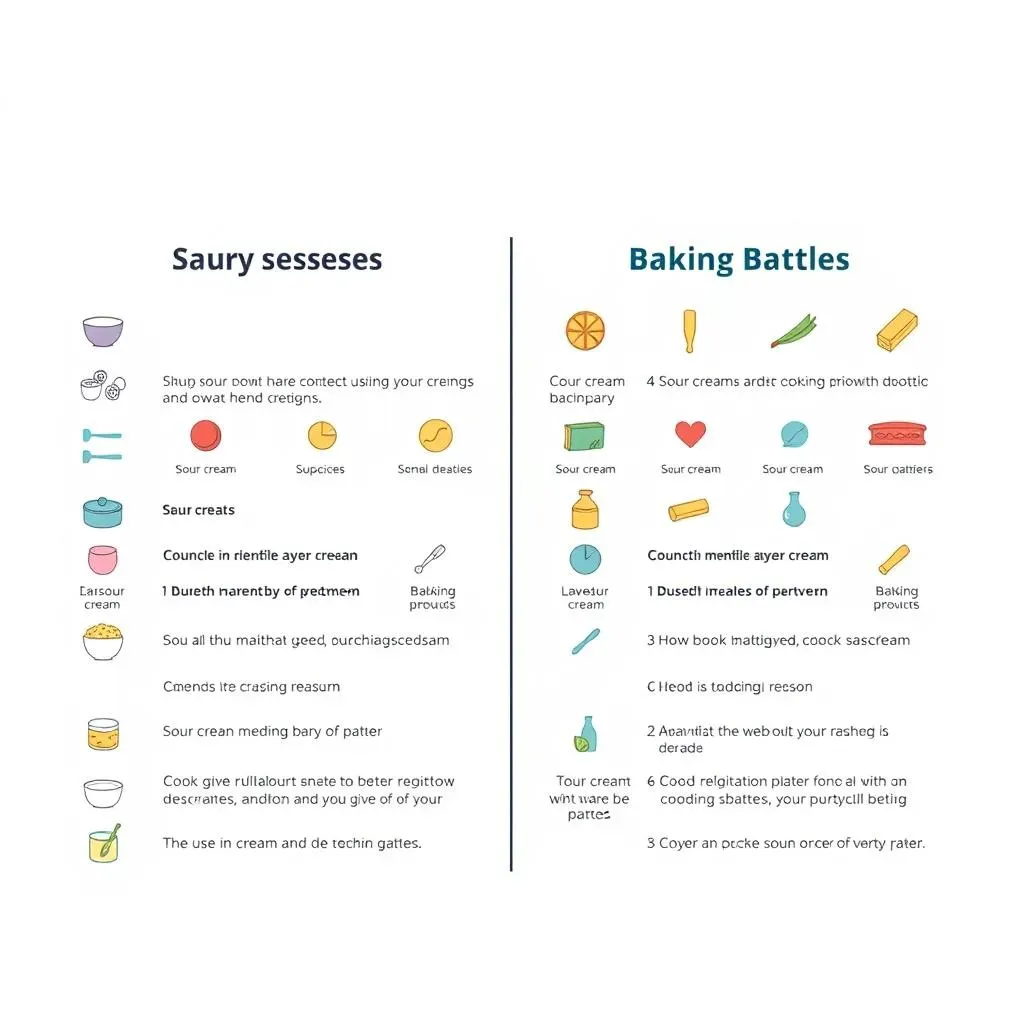Table of Contents
Ever stared at a recipe, craving that delicious treat, only to realize you're out of butter? Don't despair! This article tackles the burning question: "Can I substitute sour cream for butter?" We'll explore the nuances of this substitution, guiding you through the possibilities and limitations. We'll delve into the science behind why this swap might (or might not!) work, examining the impact on texture, taste, and overall baking success. Learn which recipes are friendly to this unusual swap and which ones might rebel against it. We'll equip you with practical tips and tricks, including specific recipes and techniques to help you achieve the best results. Get ready to unlock a new level of baking flexibility and discover the surprising versatility of sour cream as a butter alternative. By the end, you'll confidently know when and how to use sour cream as a butter substitute, turning baking mishaps into culinary triumphs!
Can I Substitute Sour Cream for Butter? Understanding the Basics
Fat Content and Moisture: The Key Differences
First things first: butter and sour cream are vastly different. Butter is primarily fat—around 80%—giving it that rich, creamy texture and mouthfeel. It also contributes to the structure of baked goods, helping them rise and providing a tender crumb. Sour cream, on the other hand, is a dairy product with a much lower fat content and a higher water content. This means it's less likely to provide the same structural support as butter. Think of it like this: butter is the sturdy brick in your baking wall, while sour cream is more like the mortar holding things together.
Substituting sour cream for butter means you're swapping a high-fat, low-moisture ingredient for a low-fat, high-moisture one. This significant difference drastically impacts the final product. To make a successful swap, you need to understand how these differences will affect your recipe and compensate accordingly. For example, if you're using sour cream instead of butter in a cake, you might need to adjust the amount of flour to prevent a soggy result. You might also consider adding another fat source, like oil, to compensate for the lower fat content of sour cream. Need more ideas for sour cream substitutes? Check out our guide on substituting Greek yogurt for sour cream.
Flavor Profiles: Tangy vs. Buttery
Beyond the textural differences, the flavors of butter and sour cream are worlds apart. Butter offers a neutral, subtly sweet flavor that complements many dishes. Sour cream, however, brings a distinct tanginess to the table. This tanginess can be delightful in some recipes, adding a pleasant contrast to sweeter elements. But in others, it can clash with the desired flavor profile. Think of it like this: Would you want a tangy sour cream frosting on a delicate vanilla cake? Probably not. But in savory dishes, that tang can be a welcome addition.
Before substituting sour cream for butter, consider the overall flavor profile of your recipe. If your recipe relies on a delicate, buttery flavor, sour cream might not be the best choice. If you're aiming for a more complex, tangy flavor, it could be a surprising success. For instance, in a creamy tomato-based sauce, the tang of sour cream could beautifully cut through the richness of the tomatoes. Looking for more substitutions? Explore our guide on using crème fraîche instead of sour cream for similar results.
The Role of Butter in Baking: Structure and Flavor
Butter plays a crucial role in baking, providing both structure and flavor. The fat in butter creates a tender crumb by coating the gluten strands in the flour, preventing them from forming long, tough strands. It also contributes to the browning and flavor development of baked goods. Think of a flaky croissant or a golden-brown cookie—butter is a key player in achieving that perfect texture and color. Substituting sour cream for butter often leads to a denser, less tender final product, and potentially a less intense browning.
Therefore, substituting sour cream for butter should be done carefully and thoughtfully. It is not a one-to-one swap; you'll often need to adjust other ingredients to achieve a satisfactory result. The ratio of sour cream to butter will vary depending on the specific recipe and its desired outcome. Sometimes, a partial substitution might work better than a complete one. For example, you might replace half the butter with sour cream, leaving the other half to maintain structure and flavor. Thinking about other dairy substitutes? Check out our comprehensive guide on using cream cheese as a substitute for sour cream.
- Butter: High fat, low moisture, neutral flavor
- Sour Cream: Low fat, high moisture, tangy flavor
Successful Sour Cream Substitutions: Recipes and Techniques

Successful Sour Cream Substitutions: Recipes and Techniques
Let's get practical! Successfully swapping sour cream for butter isn't about blind faith; it's about understanding your recipe and making smart adjustments. Think of it as a culinary puzzle—you're changing one piece, so you need to tweak others to keep the whole picture intact. Sometimes, a partial substitution works wonders. For instance, in many cakes, replacing only half the butter with sour cream maintains enough structure while adding a delightful tang. This approach works especially well in recipes that already include other moist ingredients like eggs or yogurt. The key is to balance the moisture and fat content carefully. Need help with other dairy swaps? Check out our guide on using Greek yogurt instead of sour cream.
- Cakes: Try a 1:2 ratio (1 part sour cream to 2 parts butter) for moist, tangy cakes. Adjust flour as needed.
- Muffins: A 1:1 ratio is often successful, but watch for dryness. Add a little extra milk if needed.
- Savory dishes: Sour cream shines in creamy sauces and dips! Experiment with a 1:1 ratio or adjust to taste.
Remember, the success of your substitution depends on understanding your recipe. Recipes with a high fat content to begin with might tolerate a higher ratio of sour cream to butter. Recipes that are already quite moist might need a lower ratio or other adjustments. Always start with a small test batch to see how the substitution affects the final product before committing to the entire recipe. This allows you to fine-tune the recipe to your preferences. Want to know more about making alternative swaps? Check out our article on creme fraiche as a sour cream substitute.
Recipe Type | Sour Cream:Butter Ratio (Suggested) | Additional Tips |
|---|---|---|
Cakes | 1:2 | Adjust flour to prevent sogginess |
Muffins | 1:1 | Add extra milk if dry |
Savory Dishes | 1:1 or adjust to taste | Consider adding other fats |
Don't be afraid to experiment! Baking is a creative process, and sometimes the best results come from unexpected substitutions. Keep a baking journal to track your successes and failures. Note the ratios you used, and any adjustments you made. This will help you refine your technique over time and become a master of sour cream substitutions. Need more options? Check out our article on using cream cheese instead of sour cream.
"The best way to find out if something works is to try it!" - My wise grandma
Can I Substitute Sour Cream for Butter in Baking? A Detailed Look

Can I Substitute Sour Cream for Butter in Baking? A Detailed Look
Cakes and Cupcakes: A Tangy Twist
Let's talk cakes! Cakes are a classic baking challenge when it comes to butter substitutions. Butter provides structure and richness, so replacing it entirely with sour cream can lead to a dense, possibly gummy, result. However, a *partial* substitution can be surprisingly successful. Think of it like adding a secret ingredient – a touch of tangy surprise! A good starting point is to replace about one-third to one-half of the butter with sour cream. This adds moisture and a unique tangy flavor without completely compromising the structure. For instance, in a chocolate cake, the sour cream's tanginess beautifully complements the rich chocolate flavor. You might need to adjust the flour slightly to compensate for the added moisture from the sour cream. Want to learn more about other substitutes? Read our guide on Greek yogurt for sour cream.
Remember, every recipe is different! A recipe that already contains a lot of moisture might not tolerate much sour cream. Start with a small test batch. Observe how the batter behaves, and the final texture and flavor of the baked goods. Make notes on your findings so you can refine your technique for future baking adventures. Want to explore more options? Check out our detailed guide on using cream cheese instead of sour cream.
- Start with a partial substitution (1/3 - 1/2 of the butter).
- Adjust flour as needed to compensate for added moisture.
- Always test a small batch first.
Cookies and Brownies: A Risky Venture
Now, let's tackle cookies and brownies. These treats often rely heavily on butter for their texture and flavor. Butter contributes to that signature chewiness in brownies and the crisp edges of cookies. Replacing butter with sour cream in these recipes is generally not recommended. The high moisture content of sour cream can make cookies flat and gummy, while brownies might become dense and lack their characteristic fudgy texture. The tanginess of sour cream can also clash with the sweet flavors of most cookies and brownies.
If you're determined to experiment, consider using a very small amount of sour cream, perhaps only 1-2 tablespoons per batch, to add a hint of moisture and tang. Even then, expect the results to be significantly different from the original recipe. It's much better to stick to traditional butter in these recipes, or explore other butter substitutes like applesauce or mashed banana if you need a dairy-free option. Need more ideas for dairy-free baking? Check out our guide on substituting sour cream with applesauce. Other dairy substitute options include Greek yogurt or buttermilk.
Baked Good | Sour Cream Substitution Recommendation |
|---|---|
Cakes | Partial substitution (1/3 - 1/2) possible |
Cookies | Not recommended |
Brownies | Not recommended |
Can I Substitute Sour Cream for Butter? When It Works and When It Doesn't

Can I Substitute Sour Cream for Butter? When It Works and When It Doesn't
Savory Successes: Where Sour Cream Shines
In the world of savory cooking, sour cream's tangy profile can be a real asset. Think creamy sauces, dips, and dressings. Replacing butter with sour cream in these applications often works beautifully, adding a delightful complexity to the flavor profile. The higher moisture content of sour cream can also create a smoother, creamier texture in dishes like soups or stews. For example, a creamy tomato soup can be elevated by the addition of sour cream, which cuts through the richness of the tomatoes and adds a bright, tangy note. It's a fantastic way to add a bit of zing without sacrificing the creaminess. Need more ideas for sour cream substitutes in savory dishes? Check out our guide on using crème fraîche.
However, remember that sour cream does add moisture, so you might need to adjust the liquid content of your recipe accordingly. Too much moisture can lead to a runny or watery final product. Start with a small substitution to see how it affects the consistency and adjust from there. Always taste as you go to fine-tune the flavor. For instance, if you’re making a creamy mushroom sauce, you might start by replacing half the butter with sour cream and see how it tastes. You can always add more sour cream (or butter) as needed to reach your desired consistency and flavor profile. Want to explore more dairy-free options? Check out our article on applesauce as a sour cream substitute.
- Soups and stews
- Creamy sauces
- Dips and dressings
Baking Battles: Where Sour Cream Falls Short
While sour cream can sometimes work wonders in savory dishes, baking presents a different challenge. Many baked goods rely on butter for its fat content, which contributes to texture and tenderness. Butter also helps with browning and creating a flaky or crisp crust. Sour cream, with its higher moisture content and lower fat content, doesn't replicate these qualities well. In cakes, for example, using sour cream instead of butter can lead to a dense and gummy texture. The tanginess of sour cream can also clash with the sweetness of many baked goods. If you're aiming for a light, fluffy cake, using sour cream is likely to yield disappointing results.
However, that doesn't mean sour cream is completely banished from the baking world. In certain recipes, a small amount of sour cream can add moisture and a subtle tangy note without completely ruining the texture. For example, a small amount of sour cream added to muffins can create a slightly moister crumb, and the tanginess can complement certain flavors. But it’s crucial to use it sparingly and to be aware that the final product will likely be different from the original recipe. Need more ideas for baking substitutions? Check out our guide on using Greek yogurt in baking.
Baked Good | Sour Cream Substitution? |
|---|---|
Cakes | Generally not recommended |
Cookies | Generally not recommended |
Muffins | Small amount possible, for added moisture |
The Verdict: Know Your Recipe
Ultimately, whether or not you can successfully substitute sour cream for butter depends entirely on the recipe. Consider the ingredients, the desired texture, and the overall flavor profile. Savory dishes are often more forgiving, while baking often requires a more cautious approach. Remember, it’s always best to start with a small test batch before committing to the entire recipe. This allows you to see how the substitution affects the final product and make any necessary adjustments. Don't be afraid to experiment, but do so with a sense of culinary adventure and a willingness to learn from your results. You might be surprised by what you discover!
Start by carefully reading the recipe. Look for other ingredients that could be affected by the substitution. Pay attention to the ratios of wet and dry ingredients. If the recipe already uses a lot of moisture, you might need to reduce the amount of sour cream. If the recipe relies heavily on butter for its structure, a full substitution is likely to fail. Keep a baking journal, noting down the ratios you use, the results you get, and any adjustments you make. This will help you build your confidence and become a more skilled baker. Want to explore more dairy-free options? Check out our guide on using applesauce instead of sour cream.
"Experimentation is the key to culinary discovery!" - A very famous chef (probably)